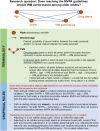How to develop causal directed acyclic graphs for observational health research: a scoping review
- PMID: 39327907
- PMCID: PMC11875439
- DOI: 10.1080/17437199.2024.2402809
How to develop causal directed acyclic graphs for observational health research: a scoping review
Abstract
Causal directed acyclic graphs (DAGs) serve as intuitive tools to visually represent causal relationships between variables. While they find widespread use in guiding study design, data collection and statistical analysis, their adoption remains relatively rare in the domain of psychology. In this paper we describe the relevance of DAGs for health psychology, review guidelines for developing causal DAGs, and offer recommendations for their development. A scoping review searching for papers and resources describing guidelines for DAG development was conducted. Information extracted from the eligible papers and resources (n = 11) was categorised, and results were used to formulate recommendations. Most records focused on DAG development for data analysis, with similar steps outlined. However, we found notable variations on how to implement confounding variables (i.e., sequential inclusion versus exclusion). Also, how domain knowledge should be integrated in the development process was scarcely addressed. Only one paper described how to perform a literature search for DAG development. Key recommendations for causal DAG development are provided and discussed using an illustrative example.
Keywords: Directed acyclic graph; causal diagram; causal inference; development; guidelines; recommendations.
Conflict of interest statement
PWGT is a director of Causal Thinking Ltd, which provides causal inference research and training. PWGT may therefore benefit from any study that demonstrates the value of causal inference methods.
Figures







References
-
- Arksey, H., & O'Malley, L. (2005). Scoping studies: Towards a methodological framework. International Journal of Social Research Methodology, 8(1), 19–32. doi:10.1080/1364557032000119616 - DOI
-
- Barnard-Mayers, R., Childs, E., Corlin, L., Caniglia, E. C., Fox, M. P., Donnelly, J. P., & Murray, E. J. (2021). Assessing knowledge, attitudes, and practices towards causal directed acyclic graphs: A qualitative research project. European Journal of Epidemiology, 36(7), 659–667. doi:10.1007/s10654-021-00771-3 - DOI - PMC - PubMed
-
- Barnard-Mayers, R., Kouser, H., Cohen, J. A., Tassiopoulos, K., Caniglia, E. C., Moscicki, A.-B., Campos, N. G., Caunca, M. R., Seage III, G. R., & Murray, E. J. (2022). A case study and proposal for publishing directed acyclic graphs: The effectiveness of the quadrivalent human papillomavirus vaccine in perinatally HIV Infected girls. Journal of Clinical Epidemiology, 144, 127–135. - PMC - PubMed
-
- Bollen, K. A., & Pearl, J. (2013). Eight myths about causality and structural equation models. In S. Morgan (Ed.), Handbook of causal analysis for social research (pp. 301–328). Springer.
Publication types
MeSH terms
LinkOut - more resources
Full Text Sources
